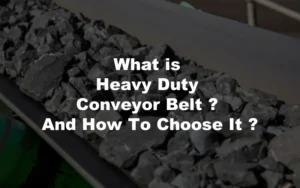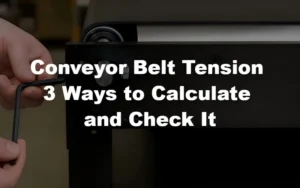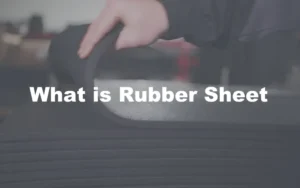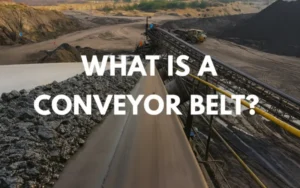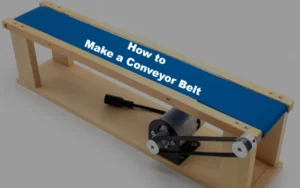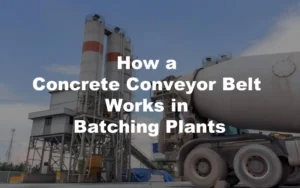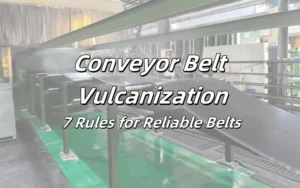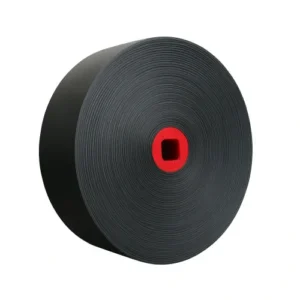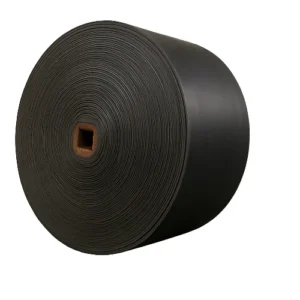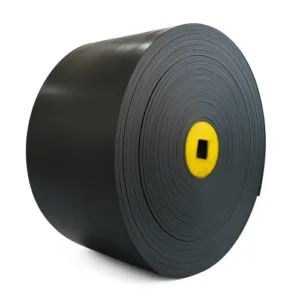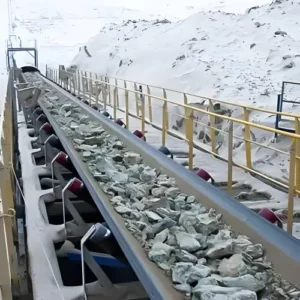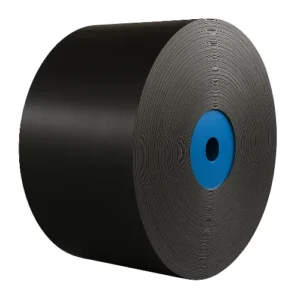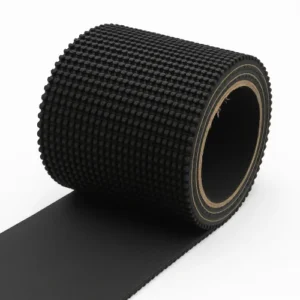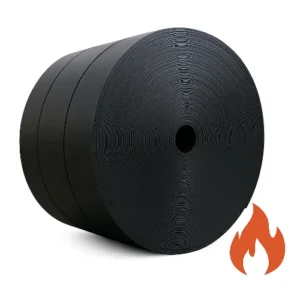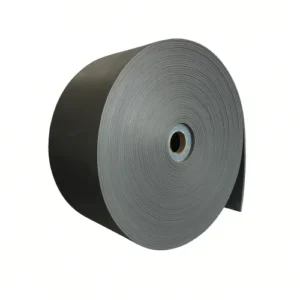1.Repair Conveyor Belt Problems: Complete Repairability Ratings
Anyone who works with a conveyor belt knows it won’t stay flawless forever. Whether it’s carrying ore in a mine, clinker in a cement plant, or grain in a port, the constant stress leaves marks. The good news? Many of these problems can be managed with the right repair conveyor belt techniques before replacement becomes necessary. Over time I’ve learned that most issues are not about “bad products” but about tough operating conditions. Let’s go through the most common kinds of damage and see what can be fixed, and what usually means it’s time for a new rubber conveyor belt.

Not all conveyor belt damage is created equal, and that’s where repairability ratings come in. To make it easier, let’s use a simple color code:
🟢 Green means the issue is easily repairable with common methods like rubber conveyor belt repair or patching.
🟡 Yellow signals a moderate repair conveyor belt challenge—you can fix it, but it may not hold forever, or it needs more advanced work.
🔴 Red warns you that the problem is severe, where even the best conveyor belt splice or conveyor belt stitching won’t restore long-term strength, and replacement is often the better call.
1. Surface Wear (🟢 Repairable)
Probably the most common sight. The top rubber layer thins out, and sometimes the fabric shows through. This doesn’t automatically mean the end of the rubber conveyor belt. With the right repair conveyor belt method—like cold bonding for small patches or hot vulcanization for larger areas—you can keep it running. Replacement is only necessary when more than 10% of the conveyor belt length is worn or cover thickness drops below 1 mm.
2. Cracks and Aging (🟡 Moderate)
Heat, ozone, and sunlight can cause small cracks, just like an old rubber band left in the sun. Light cracks? You can sand and reseal. Deep, spreading cracks across the conveyor belt? At that point, rubber conveyor belt repair won’t hold for long. Storing the belt indoors and avoiding extreme temperatures helps prevent this.
3. Blisters or Bubbles (🟡/🔴 Risky)
Moisture or contamination during a conveyor belt splice can cause bubbles between layers. A small blister can be cut out and patched, but large or spreading blisters usually signal replacement. Yes, you can temporarily repair conveyor belt blisters, but the smarter move is preventing them by keeping splicing areas clean and dry.
4. Edge Wear (🟢 Repairable)
Edges suffer when the conveyor belt runs off track or rubs against chute walls. You’ll notice fraying or missing pieces. These can be trimmed and resealed as part of a repair conveyor belt job. But if edge loss takes more than 10% of the belt’s width, capacity suffers and replacement becomes likely.
5. Edge Cracks and Delamination (🟡 Moderate)
When water and dust get into the edges, the rubber conveyor belt layers can separate. Small areas can still be sealed, but once the cracks extend for meters, repairs don’t last. This is why factory-sealed edges and correct tracking matter. If it’s already too late, you can attempt how to repair conveyor belt edges with vulcanization, but long-term success is limited.
6. Localized Holes (🟢 Repairable)
Sharp rocks or dropped tools often punch holes in a rubber conveyor belt. Luckily, this is one of the easier jobs. Cut out the damaged area in a diamond shape, then apply top-and-bottom patches. That’s classic conveyor belt patching. Replacement is needed only when the hole is wider than 10% of the belt or too close to a splice.
7. Longitudinal Tears (🟡 Moderate)
A long slit running in the belt’s direction is a frequent headache. Tears under 300 mm? Simple repair conveyor belt patch. Between 300–1000 mm, you may add extra plies or use conveyor belt stitching for reinforcement. Once it’s over a meter long, most repairs buy you time, not a solution. Preventive tools like magnets and better chutes are the real heroes here.
8. Transverse Breaks (🟡/🔴 Critical)
A rubber conveyor belt snapping across its width is every operator’s nightmare. Emergency repair conveyor belt fixes include installing conveyor belt mechanical fasteners to get production moving again. But honestly, a new conveyor belt splice is the only way to restore strength. If multiple transverse breaks happen, replacement is the only logical decision.
9. Splice Failures (🟢 with Re-splicing)
Splices can peel, bubble, or crack if not done properly. Once this happens, redoing the conveyor belt splice is the only reliable way to repair conveyor belt damage. Cold splicing can work as a stopgap, but hot vulcanization gives lasting results.
10. Mechanical Fastener Failures (🟢 Replaceable)
Conveyor belt mechanical fasteners are widely used because they’re quick and practical. But they loosen or break over time. Luckily, this is one of the easiest repair conveyor belt tasks: replace or reinstall the fasteners. Regular checks save you a lot of trouble.
11. Conveyor Belt Misalignment (🟢 Adjustable)
If a conveyor belt drifts to one side, you’ll see uneven wear and possibly overheating on the edges. Fortunately, this is usually solved by adjusting pulleys or frames, or adding self-aligning rollers. Unless misalignment has already caused deep delamination, you can repair conveyor belt tracking without replacement.
12. Conveyor Belt Slippage (🟢 Manageable)
When the drive pulley slips, the conveyor belt slows, smokes, or overheats. The fix is often simple: adjust tension, clean the pulley, or change lagging. That’s how you quickly repair conveyor belt slippage. Only when the belt surface hardens or absorbs oil permanently is replacement required.
13. Creases and Deformation (🟡 Moderate)
Improper storage sometimes leaves a rubber conveyor belt looking bent out of shape. Minor creases flatten after some time or light running. Severe folds that cut into the carcass require cutting and a new splice. Yes, you can how to fix a conveyor belt with creases, but better storage avoids this headache altogether.
14. Large-Scale Delamination (🔴 Severe)
The toughest case: widespread layer separation in a rubber conveyor belt. Small patches are possible, but when delamination spreads, no rubber conveyor belt repair will hold. Replacement is the only cost-effective solution.
What These Repair Ratings Mean for You
Looking at all these scenarios, you can see that not every damaged rubber conveyor belt is destined for the scrap pile. Some issues are quick to repair conveyor belt with patches or fasteners, while others demand a full conveyor belt splice. And when delamination or severe breaks set in, replacement is the smarter move.
Now that we’ve covered the big picture, let’s zoom in on one of the most common issues—surface wear—and walk through exactly how to fix a conveyor belt when the top cover starts wearing down.
2.Conveyor belt repair solutions
2.1 How to Repair Conveyor Belt Surface Wear
Surface wear is something every operator faces sooner or later. When the top cover of a conveyor belt thins down or starts showing the fabric, it doesn’t automatically mean it’s the end. In fact, knowing how to repair conveyor belt surface wear is one of the most practical skills you can have.
The first step is diagnosis. Measure the cover thickness at multiple points. If the remaining cover rubber is still above 1–2 mm and the carcass is intact, you can confidently go for rubber conveyor belt repair instead of replacement. Minor spots can be handled with cold bonding—basically cleaning, applying adhesive, and sticking a patch. It’s a quick conveyor belt patching method that works well for emergency cases.
For larger areas of wear, hot vulcanization is the champion. This process applies heat and pressure to bond new rubber onto the worn surface, making the repair conveyor belt solution nearly as strong as the original. It takes longer and requires equipment, but if you want to extend belt life by years instead of weeks, this is the way.
Sometimes customers ask if they can just ignore small spots of exposed fabric. My advice: don’t. Once water and dust get into the carcass, the damage spreads fast. A simple rubber conveyor belt repair can turn into a costly replacement if delayed. If you’re wondering how to fix a conveyor belt before it fails, patch early and patch properly.
Preventive measures are just as important as repairs. Install proper chute liners, buffer rollers, and keep the belt aligned to avoid uneven wear. Scraper pressure is another silent culprit—too tight, and it chews your belt; too loose, and it leaves material that wears later.
The bottom line: you can often repair conveyor belt surface wear successfully, but prevention is what really saves you money. Think of it like car tires—you can patch a puncture, but regular rotation and pressure checks make a bigger difference.

2.2 How to Repair Conveyor Belt Cracks and Aging
When I hear operators talk about a cracked conveyor belt, I always picture the surface like dry land after weeks without rain. It doesn’t mean the belt is finished, but it does mean action is needed. From years of customer feedback, one thing is clear: if you don’t repair conveyor belt cracks early, you’ll end up paying much more later.
The small cracks you first notice are usually just on the cover. They happen because of heat, ozone, or sometimes poor storage. At this stage, rubber conveyor belt repair is fairly simple. A light sanding, cleaning, and protective coating often buys you months, if not years. It’s not a miracle cure, but think of it as sunscreen for your belt—better late than never.
When cracks deepen but haven’t cut into the carcass, that’s when I recommend patching. Cold bonding works for narrow zones, while vulcanized patches give stronger results for wider areas. This kind of conveyor belt patching is common in hot, dusty plants where covers age faster. Done properly, it keeps the belt flexible and running safely.
If cracks have already reached the fabric layers, that’s a different story. Some try conveyor belt stitching or sealants, but honestly, these are short-term tricks. To properly repair conveyor belt damage at this point, you usually need to cut out the section and make a new conveyor belt splice. Once the carcass is exposed, strength is compromised, and no surface treatment will restore it fully.
Aging is the silent partner to cracking. Rubber hardens with time; flexibility disappears, and suddenly the belt behaves more like plastic. Operators often ask me how to fix a conveyor belt that’s gone stiff with age. My answer is straightforward: patch where you can, but prepare for replacement. A tired conveyor belt can be kept alive for a while, but not forever.
The smartest approach is prevention. Keep belts away from direct sunlight, store them indoors, and avoid running them near ozone-producing equipment like large motors. Regular inspections are key. If you catch the first cracks and know how to repair conveyor belt damage before water reaches the carcass, you extend service life and save a lot of downtime.
So here’s the takeaway: cracks and aging are inevitable, but not always fatal. Shallow cracks? Handle them with coatings and rubber conveyor belt repair. Moderate damage? Go for conveyor belt patching. Deep cracks into the carcass? Only a conveyor belt splice or replacement will truly restore performance. The trick is acting early—because once the carcass starts breaking down, the game changes.

2.3 How to Repair Conveyor Belt Blisters and Bubbles
Blisters on a conveyor belt are more than cosmetic—they’re weak spots waiting to spread. Over time, air or moisture trapped between layers pushes upward, creating bubbles that bend with every rotation. To repair conveyor belt blisters properly, you need to act with precision, not just patch over the surface.
Here’s how I’ve seen it done effectively in many plants. If the blister is small and isolated, the first step is to puncture it and release trapped air. Then use an angle grinder to carefully grind down the raised section until you reach solid rubber. Once the surface is smooth and fresh rubber is exposed, apply a layer of cold vulcanizing adhesive. Add a rubber patch, roll it firmly to expel air pockets, and let it cure. This simple rubber conveyor belt repair method works best for bubbles less than a few centimeters across.
For larger blisters, hot vulcanization is more reliable. Cut out the damaged portion in a diamond or oval shape to prevent stress concentration. Clean the cavity, grind the bonding surface, and apply fresh rubber sheet with the right vulcanizing pressure and temperature. This type of conveyor belt patching restores structural strength, making the repair conveyor belt process almost as good as new.
If the blister runs across the full width or appears in clusters, a patch may only buy you time. In those cases, the best way to repair conveyor belt damage is to cut away the entire weakened section and install a new conveyor belt splice. It’s more work, but it guarantees the belt won’t peel again under heavy loads. Some operators attempt temporary fixes like conveyor belt stitching, but these should only be seen as emergency measures.
Of course, knowing how to fix a conveyor belt is not just about repairs—it’s about prevention. Keep the splicing area dry and dust-free, control humidity during installation, and make sure curing pressure is uniform. Most blister cases I’ve heard about come from shortcuts during splicing, not from the rubber itself.
So, the bottom line is clear: you can repair conveyor belt blisters if they are caught early and handled with proper grinding, cleaning, and bonding. But if they spread across the length or recur after repair, replacement is the smarter investment. Prevention, as always, is the cheapest form of rubber conveyor belt repair.

2.4 How to Repair Conveyor Belt Edge Wear
Edge wear is one of the most common issues we hear about from users of conveyor belts. Rough edges, missing chunks, or exposed fabric layers don’t just look bad—they reduce the usable width and invite moisture into the carcass. The good news is that you can often repair conveyor belt edges with straightforward methods, as long as you act early.
For light wear, the process is simple. Start by trimming away the loose or frayed rubber with a sharp knife or cutter to restore a clean line. Then use an angle grinder to smooth the surface until fresh rubber is exposed. Once prepared, apply cold vulcanizing adhesive along the edge, pressing in firmly so the sealant penetrates. This prevents water from entering the carcass and extends the service life.
When larger chunks are missing, trimming alone is not enough. In that case, cut the damaged area into a neat shape—preferably with rounded corners to avoid stress concentration—then apply a strip of repair rubber. Bond it using cold vulcanization, or if conditions allow, hot vulcanization for a stronger finish. Roll the patch firmly to remove air, but remember: this step is about bonding the patch, not about “squeezing out bubbles.” If blisters or delamination are already present along the edge, the correct way to repair conveyor belt damage is to cut open the blister, grind to solid layers, dry thoroughly, and then rebuild the section with vulcanized rubber and a sealing strip.
For severe cases, where edge wear runs continuously for several meters or eats into more than 10% of the working width, the best option may be to cut back the edge completely and re-splice the belt. A new conveyor belt splice ensures the system can handle full load without further peeling.
Now, let’s talk prevention. From countless customer cases, I can tell you that most edge wear is not about the rubber itself but about misalignment. If the conveyor belt is running off-center, the edge will constantly rub against structures, creating wear and eventually blisters. The smartest way to avoid repeated rubber conveyor belt repair is proper tracking: align the frame and pulleys, adjust skirt boards, install self-aligning idlers, and keep feeding centered.
In short, you can repair conveyor belt edges through trimming, sealing, and patching when the damage is minor. For blisters along the edge, treat them as delamination and rebuild properly. But long-term prevention comes from alignment—because no amount of patching will last if the conveyor belt keeps running off track.

2.5 How to Repair Conveyor Belt Edge Cracking and Delamination
Edge cracking is a more serious problem than simple wear. When the edge of a conveyor belt begins to split or layers start to peel apart, water and dirt find their way inside. From there, the carcass weakens quickly. Many customers describe it as “the belt looks fine from the top, but the edge keeps opening up.” This is exactly the kind of damage where a fast and correct repair conveyor belt job makes the difference.
For small cracks, the process is not complicated. First, cut away the loose, frayed section until you reach solid material. Then grind the area with an angle grinder to expose clean rubber. Dry the surface well—any moisture will ruin the bond. After that, apply cold vulcanizing adhesive and place a narrow sealing strip over the edge. Roll it down firmly so the strip sits tight. This method of rubber conveyor belt repair can extend life for a while, but cold bonding alone usually has a shorter lifespan on the edge.
When the crack runs longer or the fabric layer is exposed, hot vulcanization is the safer option. Remove the damaged part of the edge completely, making a smooth cut line. Prepare both surfaces, apply repair rubber, and cure it under heat and pressure. Adding a hot-vulcanized edge strip not only closes the crack but also protects against new delamination. This form of conveyor belt patching is stronger and holds up better against moisture.
Sometimes I see belts where the edge crack continues for several meters or cuts through more than one ply. In these cases, patching will not bring back full strength. The practical choice is to cut out the weak length and make a new conveyor belt splice. If the belt is already old, many users decide to replace it altogether rather than invest in repeated rubber conveyor belt repair.
Prevention is simple in theory but often overlooked. Most edge cracks come from two things: misalignment and poor sealing. If a conveyor belt runs off track, one side rubs against the structure, slowly peeling the edge. If the edge was never sealed properly, water seeps in and accelerates delamination. The best way to avoid constant repair conveyor belt work is to keep the belt centered, control skirt pressure, and store belts in dry conditions before installation.
Edge cracking may start small, but it rarely stays that way. Once layers begin to separate, the damage spreads. Repairing early with proper vulcanization can give back months of service life. Waiting too long usually means cutting, splicing, or replacing. A clean edge is not just cosmetic—it is the difference between a belt that keeps running and one that fails when you need it most.

2.6 How to Repair Conveyor Belt Holes
A hole in a conveyor belt might look small, but it is one of the fastest ways for damage to spread. Once the carcass is exposed, moisture and tension do the rest. From customer feedback, I know that a quick, proper repair conveyor belt job here often makes the difference between a short stop and a long shutdown.
The first rule is to shape the damaged area. Do not leave ragged cuts. Take a knife and trim the hole into a round or diamond pattern. Sharp corners always tear further. Once shaped, use an angle grinder to roughen the area until clean rubber shows. Wipe away dust and let the surface dry. Apply cold vulcanizing adhesive to both the belt and the patch. Place the patch over the hole, press it down, and roll from the center outward. This simple method of rubber conveyor belt repair works well on holes smaller than a few centimeters.
Larger impact damage needs a stronger solution. When the hole cuts through multiple layers, the best way to repair conveyor belt strength is hot vulcanization. Cut out the entire weakened spot in an oval or diamond. Grind the edges smooth, clean carefully, and fit rubber sheets both on the top and underside. Place them under a vulcanizing press with the right temperature and pressure. Once cured, the patch is bonded into the belt body, not just sitting on top. This kind of conveyor belt patching restores flexibility and load capacity.
If the hole is near a splice or covers more than ten percent of the belt width, patching alone is not safe. In those cases, cut out the section and install a new conveyor belt splice. For emergencies, some operators use conveyor belt stitching or conveyor belt mechanical fasteners to close the gap and restart the system. These are temporary tools, not long-term repairs.
Most of the time, holes come from the loading zone. Heavy rocks, scrap, or steel drop with force and punch through the top cover. The fix is not only to repair conveyor belt holes after they happen, but also to reduce the risk in the first place. Impact bars, cushion rollers, and shorter drop heights all help. Even simple steps like removing stray bolts from material flow prevent a lot of damage.
A hole may not seem urgent, but it grows with every rotation of the conveyor belt. Deal with it while it is small and the solution is quick. Leave it too long, and you will be planning a splice instead of a patch. The smartest operators are the ones who know how to repair conveyor belt holes early, before they grow into something that no patch can save.

2.7 How to Repair Conveyor Belt Longitudinal Tears
A longitudinal tear is one of the most worrying failures on a conveyor belt. Unlike a hole or edge crack, it runs along the direction of travel, often caused by a trapped bolt, rebar, or other sharp object. Once the fabric is cut in line with the tension, the tear can spread fast. Knowing how to repair conveyor belt tears in time is essential to keep production safe.
For short tears, under 300 mm, a patch is usually enough. First, cut the torn edges into a neat shape with rounded ends. Grind the surface to expose fresh rubber and clean it carefully. Then apply cold vulcanizing adhesive and press on a repair patch, rolling it out to avoid trapped air. This simple method of rubber conveyor belt repair works when the tear is small and does not affect the strength of the whole carcass.
For medium tears, between 300 mm and 1000 mm, reinforcement is needed. Here the best approach is to apply a vulcanized patch and add extra anti-tear plies on both sides of the tear. These plies act like stitching, spreading the load across the damaged section. Hot vulcanization gives the strongest result, as the repair becomes part of the belt body. This form of conveyor belt patching holds up well under normal loading.
For long tears, over one meter, most fixes are only temporary. Some sites use conveyor belt stitching with fasteners, or apply long reinforcement strips held by cold bonding. Others use conveyor belt mechanical fasteners to close the tear and get the system running again. But these solutions are just stopgaps. In practice, the safest way to repair conveyor belt damage of this scale is to cut out the section and install a new conveyor belt splice.If the conveyor belt has reached its lifespan, replacing it is the best solution.
Prevention is always better. Almost every longitudinal tear starts with a foreign object. Strong magnets, metal detectors, and grizzly screens help keep bolts, scrap, and steel rods out of the material stream. Another common safeguard is lagging the drive pulley. A lagged pulley grips the belt better and reduces the risk of objects dragging into the carcass.
A small tear today can be a total shutdown tomorrow. Acting early with proper rubber conveyor belt repair methods can save hours of downtime. Leave it too long, and the only option will be cutting and splicing. That’s why operators who know how to repair conveyor belt tears quickly often avoid the costly failures that others face.

2.8 How to Repair Conveyor Belt Transverse Breaks
When a conveyor belt snaps across the width, everything stops. No workaround moves material until the break is secured. The goal is simple: repair conveyor belt strength fast, then choose a durable fix when time allows.
First, make it safe. Lock out power. Tag the drive. Clear material. Support the conveyor belt with clamps so it won’t drop while you repair conveyor belt damage.
2.8.1 Fast restart (minutes to hours).
Use conveyor belt mechanical fasteners across the full width.
- Square the ends. Trim back to sound rubber.
- Mark a centerline so both sides align when you repair conveyor belt
- Drill per the fastener template. Deburr holes.
- Install fasteners row by row. Set the correct setting torque.
- Add a thin cover patch over the fasteners with cold adhesive. Roll from center out to vent air. This doesn’t “press away bubbles”; it bonds the patch while you repair conveyor beltqui
This gets you running, but plan the permanent repair conveyor belt work soon.
2.8.2 Durable fix (planned downtime).
Cut out the shattered section and make a hot vulcanized conveyor belt splice.
- Measure damage. Cut back 150–300 mm to clean carcass on each side.
- Choose the joint: step or finger, following EP/NN practice. Mark plies.
- Buff to fresh rubber (#24–36 grit). Vacuum dust. Solvent clean. Let it flash off.
- Lay splice plies and covers to spec. Cement as required.
- Cure under the correct temperature, pressure, and time. Cool under pressure.
- Trim flash. Check thickness and tracking. This is the most reliable way to repair conveyor beltintegrity for heavy service.
If hot work isn’t possible, a cold splice can repair conveyor belt continuity on light duty lines. It’s serviceable, but not equal to hot curing. Some sites bridge with top-and-bottom patches to carry light loads; use that only as a short step while you schedule the real repair conveyor belt splice.
2.8.3 When to replace instead of trying to repair.
Multiple breaks in a short distance. A break on a small pulley zone. Severe aging and hard cover. In these cases, trying to repair conveyor belt strength again wastes time and adds risk.
2.8.4 Prevention that actually works.
Set overload protection and plug-chute interlocks. Lower drop height and use impact beds. Keep correct tension. Lag the drive pulley for grip. Inspect transfer points for trapped steel. Do these, and you repair conveyor belt failures far less often.
If you need a quick checklist on how to repair conveyor belt breaks: make it safe, square and align, choose fasteners for minutes, choose vulcanized splicing for months, confirm tracking, and document cure parameters. That’s how you repair conveyor belt damage without guesswork—and how you repair conveyor belt performance to match your load again.

2.9 How To Repair Conveyor Belt Splice Cracks and Separation
A splice should be the strongest section of a conveyor belt, but in reality it is often the first place to fail. I have seen many cases where a splice starts with a small crack at the edge and then turns into full peeling. Once the layers separate, the belt loses strength and carrying capacity. Knowing how to repair conveyor belt joints quickly can prevent a costly shutdown.
2.9.1 How to recognize the problem.
Early signs include lifted edges, small bubbles under the cover, or exposed fabric at the splice line. Sometimes operators notice material leaking from the joint area. If the separation spreads more than a few centimeters, the splice needs immediate attention.
2.9.2 Repair methods.
For very small cracks, clean the area first. Use an angle grinder to remove loose rubber and expose fresh surface. Dry the joint completely, then apply cold vulcanizing adhesive. Press down a thin rubber patch and roll it firmly to remove air pockets. This form of rubber conveyor belt repair is quick, but should be treated as temporary.
For medium peeling, hot vulcanization works better. Cut back the damaged portion until only solid carcass remains. Buff both sides with coarse grit to the right roughness. Apply bonding layers step by step, lay new splice rubber, and cure under the correct pressure and temperature. Done properly, this type of conveyor belt splice can restore nearly full strength.
When the splice has failed across most of the width, the only safe solution is to cut out the entire joint and rebuild it. That means measuring a proper splice length, skiving the plies with the right angle, cleaning, drying, and hot curing. It takes more time, but this is the only reliable way to repair conveyor belt splices for long-term use.
2.9.3 Prevention.
Most failures come from poor preparation: uneven buffing, dust or moisture in the layers, or curing outside the correct temperature. Using the right adhesive for the belt compound is just as critical. During service, alignment is key. A misaligned system adds side stress and almost always causes splice peeling. Regular checks for cracks, combined with proper cleaning and dry storage of repair materials, greatly reduce failures.
In practice, the splice is both the heart and the weakness of a conveyor belt. If you want fewer shutdowns, invest the time in making a correct splice and follow the proven steps of rubber conveyor belt repair. Small shortcuts during preparation almost always lead to bigger repairs later.

2.10 How to Repair Conveyor Belt Mechanical Fastener Failures
When conveyor belt mechanical fasteners break or pull loose, the joint loses alignment and the belt cannot run smoothly. The good news: this is usually one of the fastest ways to repair conveyor belt function.
2.10.1 First, make it safe.
Shut down power. Lock and tag the drive. Release belt tension. Support the belt ends with clamps so they don’t slip.
2.10.2 Quick fix (minutes).
Reinstall or replace the damaged fasteners.
- Remove broken fasteners with the right tool, not by hammering.
- Trim frayed rubber edges. Square the belt ends.
- Mark the centerline to keep alignment.
- Drill or punch new holes only if the old holes are stretched.
- Insert the new conveyor belt mechanical fastenersrow by row.
- Tighten bolts or set rivets to the recommended torque.
- If possible, apply a thin cover strip with cold adhesive to protect the joint.
This method restores service quickly, but watch for repeated failures. If fasteners keep breaking, it signals deeper problems.
2.10.3 Durable repair (planned downtime).
Switch from fasteners to a vulcanized splice.
- Measure the joint length required foryour rubber conveyor belt repair.
- Cut back both ends to clean carcass.
- Prepare a step or finger joint.
- Buff surfaces, clean with solvent, and let them dry.
- Apply cement and lay splice sheets.
- Hot cure with the right temperature and pressure.
- Check thickness and confirm alignment.
A vulcanized conveyor belt splice restores full strength and runs more smoothly than mechanical fasteners.
2.10.4 When to replace instead of repair.
If the belt holes are stretched too wide. If the carcass near the fastener row is torn. If repeated re-fastening fails within weeks. At this point, cutting out the joint and rebuilding is the safer choice.
2.10.5 Prevention that works.
- Choose fasteners rated for belt thickness and pulley diameter.
- Keep proper tension—over-tightening causes metal fatigue.
- Re-tighten bolts during inspections.
- Use cover patches to reduce wear on exposed metal.
Checklist on how to repair conveyor belt fastener damage: lock out, release tension, square ends, insert new fasteners, torque correctly, and cover if possible. For long-term service, plan a vulcanized splice. This way you not only repair conveyor belt damage quickly, but also keep your system running without repeated shutdowns.

2.11 How to Repair Conveyor Belt Tracking Problems
When a conveyor belt starts drifting off to one side, you can almost predict what comes next: the edge begins to rub, small chunks of rubber disappear, and soon you’re not just fixing alignment—you’re also paying for rubber conveyor belt repair. And the cycle doesn’t stop there. Once the edge is damaged, the belt loses balance and drifts even more.
2.11.1 Start with the basics
Stop the system and lock it out. Clear off any load, then just look closely. In many cases, tracking problems show their cause right away: one idler leaning, a pulley lagging unevenly, or material being dumped off-center. Spotting these small things early prevents bigger jobs later.
2.11.2 Small corrections that make a big difference
- Adjust the height of idlers. If one side is slightly lower, the belt will always chase that side.
- Clean return rollers. A lump of stuck material is enough to pull the belt sideways.
- Re-check the loading chute. If rocks or ore keep hitting one edge first, you’ll never hold tracking steady.
- Balance the tension. One side too tight and the belt will fight you all day.
These are simple moves, but they often stop the edge from turning into the next conveyor belt repair problem.
2.11.3 When it’s more than a quick fix
If you keep seeing the same wear marks, it means the line itself may be out of square. I’ve seen customers measure the frame diagonals and discover a twist they never noticed before. A worn pulley or a splice cut a few millimeters off-center can do the same thing. In those cases, the only reliable solution is to cut out the bad splice and make a proper hot vulcanized conveyor belt splice. Training idlers can also help in plants where the load shifts constantly.
2.11.4 Knowing when to stop patching
If the edge is already eaten back more than ten percent of the width, or cracks have gone down into the carcass, patching won’t hold. That’s when you splice in a new section instead of throwing more time at endless rubber conveyor belt repair.
2.11.5 Keeping it straight in the long run
The easiest way to avoid chasing misalignment is to set things right from the start. Make sure the frame is square, pulleys are clean, and loading is centered. After any splice, check the belt runs straight before loading again. Do that, and you cut down both tracking complaints and edge damage.
Misalignment is not just a nuisance; it’s a loop that feeds itself. Stop the loop early, and you don’t just repair conveyor belt damage—you protect the whole line from breaking down again.
![]()
2.12 How to Repair Conveyor Belt Slippage
Slippage shows itself fast: a hot drive pulley, fine black dust, and a speed drop even though the motor amps look normal. Chalk a line on the conveyor belt and on the structure—if the marks drift, you’ve got slip. The task is to repair conveyor belt traction first, then fix what caused the loss of grip.
2.12.1 What you can do right now
- Lock out. Clear the loading zone.
- Brush off mud and fines from the drive. Wet clay is a slip amplifier.
- Reset take-up to sp Too little tension makes every start a skid.
- Reduce load for the next start. A lighter pull helps you repair conveyor belttraction without shock.
- Check cleaners. Overloaded blades can carry water back to the drive; clean and re-set pressure so you actually repair conveyor beltcontact at the pulley.
2.12.2 Restore grip during a planned stop
- Re-lag the drive pulley. Ceramic or grooved rubber lagging raises friction and helps repair conveyor belttraction under wet duty.
- Add a snub pulley to increase wrap to 200–220°. More wrap = more usable friction to repair conveyor beltdrive loss.
- Verify take-up travel. If you’re at the end of stroke, you’re running out of tension authority; service the take-up so you truly repair conveyor belttension control.
- Clean oil and diesel residues. Any hydrocarbon glaze kills friction; a proper solvent wash and re-buffing of the cover can repair conveyor beltsurface bite.
- Check the splice. A thick or glazed conveyor belt splicecan skate; re-buff or rebuild if needed so you repair conveyor belt continuity and thickness.
- Consider a soft-start or VFD ramp. Lower shock lets you repair conveyor beltgrip on every start instead of tearing the
2.12.3 When patching won’t cut it
- The top cover is glass-hard, oil-soaked, or <1 mm. Replace or re-cover; that’s the only way to repair conveyor beltfriction long-term
- Drive lagging is bald or chunked. Re-lag; otherwise you’ll “repair” every week.
- Chronic carryback keeps the drive wet. Upgrade cleaners or install a dewatering roller; that’s how you truly repair conveyor beltslip, not just the symptom.
2.12.4 Root causes to confirm
- Mis-tension from a seized take-up. Free it and you actually repair conveyor belt
- Off-center loading. Fix the chute or you’ll never repair conveyor belttraction evenly across the width.
- Undersized pulley diameter for thickness. Match hardware to the rubber conveyor beltor you won’t repair conveyor belt grip under load.
2.12.5 Practical add-ons
Fit a V-plough ahead of the tail to keep rocks off the return side, upgrade to sealed skirt systems to cut water ingress, and schedule lagging inspections. These small habits repair conveyor belt reliability every day. If you still need a stop-gap, a quick cold-bonded strip can raise local friction, but plan proper rubber conveyor belt repair the next shutdown.

2.13 How To Repair Conveyor Belt Creases and Deformation
When a rubber conveyor belt shows waves, folds, or sharp creases, the problem usually began during storage or transport. Long-term pressure on one side of the roll, stacking heavy objects, or keeping the belt on a damp floor can all leave the carcass with a set. These deformations are more than cosmetic: they can pull the belt off-track, expose edges to wear, and shorten splice life.
2.13.1 Step-by-step recovery for light creases
- Unroll and relax.Place the conveyor belt flat on a clean, dry surface. Avoid laying it on hot asphalt or wet ground.
- Add controlled heat.Use heating blankets or warm air circulation (40–50 °C). The aim is to soften the rubber slowly so the plies release tension. Never use open flame.
- Run without load.Once installed, keep the conveyor running empty for several hours. This allows the belt to “train” itself onto the idlers and smooth out minor ripples.
- Seal exposed cover.If the crease leaves a raised scar, buff the spot with an angle grinder and apply a thin layer of cold vulcanizing cement. This stops moisture from creeping into the carcass.
2.13.2 What to do with severe folds
If the crease is sharp, permanent, or extends across the width, repair requires cutting:
- Mark and cut.Square off both ends of the damaged section with a straight cut.
- Prepare a splice.For EP or NN carcass, use a step or finger design. Buff the splice area to expose fresh rubber, clean with solvent, and let it flash dry.
- Assemble the plies and cover layers, then cure at the correct temperature, pressure, and time.
- Check alignment.After curing, confirm the splice thickness and straightness before restarting.
Mechanical fasteners or cold bonding can reconnect the belt in an emergency, but they should be seen as temporary rubber conveyor belt repair methods. A hot vulcanized conveyor belt splice is the only way to restore full strength.
2.13.3 When to replace
If deformation runs for several meters or if the fabric plies are broken, even the best repair may not hold. In that case, replacing the damaged length is safer and avoids repeated downtime.
2.13.4 Storage rules to prevent deformation
- Store conveyor belts on a shaft or rack, not on the floor.
- Keep rolls away from sunlight, water, and extreme temperatures.
- Do not stack heavy loads on top of a roll.
- Rotate rolls in storage every few months to avoid flat spots.
A smooth rubber conveyor belt is easier to splice, tracks better, and reduces repair costs. Most creases can be avoided before installation with careful handling.

2.14 Repair Conveyor Belt Delamination (Large-Scale Separation)
Large-area delamination happens when the layers of a rubber conveyor belt separate from each other. It can occur between the cover rubber and the fabric, or between fabric plies inside the carcass. The causes are usually water penetration, contamination with oil or chemicals, or years of overloading and bending over small pulleys. Unlike a surface crack, delamination quickly spreads and weakens the entire structure.
2.14.1 First checks before any repair
- Confirm extent.Mark the area where layers lift apart by tapping with a hammer or inspecting with a knife edge.
- Check moisture.If water or white discoloration is visible between plies, the bond strength has already dropped.
- Evaluate safety.A severely delaminated conveyor belt can snap under load, so secure the system before working.
2.14.2 Localized delamination repair
For small zones (less than 300 mm long), you can restore the surface:
- Cut out the loose layer.Remove all soft or blistered rubber until you reach solid bonding.
- Buff and clean.Use coarse grit (24–36) to roughen the carcass, then clean with solvent and allow full drying.
- Apply repair rubber.Use uncured rubber sheet with cement, layered slightly larger than the cavity.
- Hot vulcanize.Press and cure at the proper temperature and pressure to integrate the new layer.
This procedure works only when the problem is isolated.
2.14.3 Large-scale separation
When delamination extends along meters of the rubber conveyor belt, repair becomes uneconomical. Cutting out the damaged section and splicing is possible, but it requires removing long lengths and performing multiple conveyor belt splices. In practice, replacing the belt is usually the better choice for strength and reliability.
2.14.4 Temporary emergency action
In rare cases where production must restart immediately, technicians sometimes stitch the layers together using rows of fasteners or add external conveyor belt patching plates. These are stopgap measures only and cannot restore original tension capacity.
2.14.5 Preventing delamination in the first place
- Keep pulleys within the recommended minimum diameter.
- Avoid constant overloading and reduce sharp transition angles.
- Ensure splicing is done with proper curing cycles, clean surfaces, and dry conditions.
- Keep belts away from oil and chemicals not rated for resistance.
- Inspect regularly for early signs: bubbles, soft spots, or cover lift near splices.
Large-scale delamination is one of the hardest failures to manage. Small patches can hold for a while, but when the bond between layers is lost over a wide area, only replacement truly restores the rubber conveyor belt to safe working condition.
At the end of the day, every repair conveyor belt decision comes down to one question: do you want a patch that buys time, or a splice that restores trust? Choose wisely, act fast, and your rubber conveyor belt will pay you back with smooth, steady production.

3.FAQs
FAQ 1: Can every damaged conveyor belt be repaired, or do I need to replace it?
Not every case allows for a repair conveyor belt solution. Small issues—like surface wear, punctures, or minor edge cracks—can often be solved with conveyor belt patching or cold bonding. But when there is large-scale delamination, multiple transverse breaks, or severe aging of the carcass, replacement is usually the safer and more economical choice.
FAQ 2: Which is stronger: mechanical fasteners or vulcanized conveyor belt splices?
Mechanical fasteners are quick and practical when downtime must be kept to minutes, but they are not equal in strength to a hot vulcanized conveyor belt splice. A properly cured splice restores the belt’s tensile capacity and is far more durable under heavy loads. Fasteners are best treated as an emergency or short-term option, while vulcanized splicing remains the standard for long service life.
FAQ 3: How can I prevent repeated rubber conveyor belt damage after repairs?
Prevention comes from system care as much as from the rubber conveyor belt repair itself. Keep the conveyor aligned to avoid edge wear, reduce drop heights with impact beds to stop tears, and ensure correct tension to prevent slipping. Most importantly, follow strict procedures during any splice—surface prep, curing cycle, and alignment—because many failures start at poorly executed joints.


